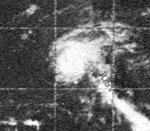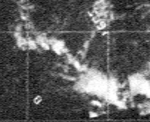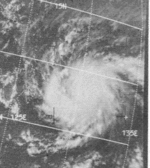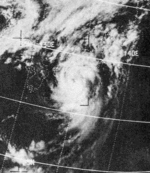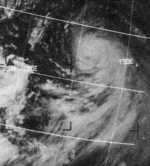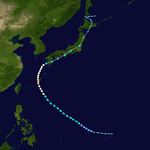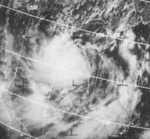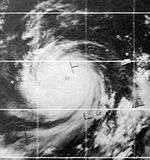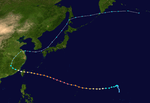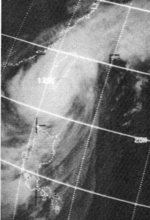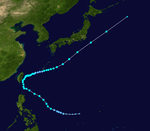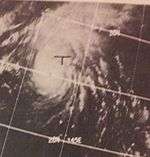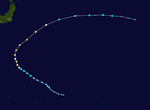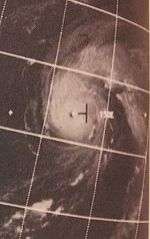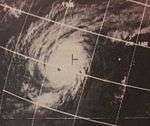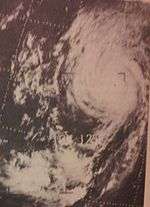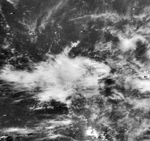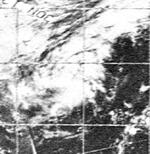| 1969 Pacific typhoon season |
|---|
|

Season summary map |
| Seasonal boundaries |
|---|
| First system formed |
January 16, 1969 |
|---|
| Last system dissipated |
December 21, 1969 |
|---|
| Strongest storm |
|---|
|
|
| Name |
Elsie |
|---|
| • Maximum winds |
280 km/h (175 mph)
(1-minute sustained) |
|---|
| • Lowest pressure |
895 hPa (mbar) |
|---|
|
|
| Seasonal statistics |
|---|
| Total depressions |
34 |
|---|
| Total storms |
23 |
|---|
| Typhoons |
13 |
|---|
| Super typhoons |
2 |
|---|
| Total fatalities |
Unknown |
|---|
| Total damage |
Unknown |
|---|
| Related articles |
|---|
|
|
|
The 1969 Pacific typhoon season was the third least-active season on record.[1] The season had no official bounds; it ran year-round in 1969, but most tropical cyclones tend to form in the northwestern Pacific Ocean between June and December. These dates conventionally delimit the period of each year when most tropical cyclones form in the northwestern Pacific Ocean.
The scope of this article is limited to the Pacific Ocean, north of the equator and west of the international date line. Storms that form east of the date line and north of the equator are called hurricanes; see 1969 Pacific hurricane season. Tropical Storms formed in the entire west pacific basin were assigned a name by the Joint Typhoon Warning Center. Tropical depressions in this basin have the "W" suffix added to their number. Tropical depressions that enter or form in the Philippine area of responsibility are assigned a name by the Philippine Atmospheric, Geophysical and Astronomical Services Administration or PAGASA. This can often result in the same storm having two names.
Systems
34 tropical depressions formed this year in the Western Pacific, of which 23 became tropical storms. 13 storms reached typhoon intensity, of which 2 reached super typhoon strength.
Typhoon Phyllis
|
Typhoon (JMA) |
|
Category 2 typhoon (SSHWS) |
|
|
| Duration |
January 16 – January 24 |
|---|
| Peak intensity |
155 km/h (100 mph) (1-min) 965 hPa (mbar) |
|---|
CMA Tropical Depression 02
|
Tropical depression (CMA) |
|
|
| Duration |
February 21 – February 23 |
|---|
| Peak intensity |
55 km/h (35 mph) (10-min) 998 hPa (mbar) |
|---|
Tropical Storm Rita
|
Tropical Storm (JMA) |
|
Tropical Storm (SSHWS) |
|
|
| Duration |
March 6 – March 9 |
|---|
| Peak intensity |
75 km/h (45 mph) (1-min) 995 hPa (mbar) |
|---|
Typhoon Susan (Atring)
|
Typhoon (JMA) |
|
Category 3 typhoon (SSHWS) |
|
|
| Duration |
April 15 – April 26 |
|---|
| Peak intensity |
195 km/h (120 mph) (1-min) 940 hPa (mbar) |
|---|
Tropical Depression Bining
|
Tropical depression (PAGASA) |
|
|
| Duration |
May 3 – May 5 |
|---|
| Peak intensity |
55 km/h (35 mph) (10-min) |
|---|
Typhoon Tess (Kuring)
|
Typhoon (JMA) |
|
Category 1 typhoon (SSHWS) |
|
|
| Duration |
July 6 – July 12 |
|---|
| Peak intensity |
130 km/h (80 mph) (1-min) 970 hPa (mbar) |
|---|
CMA Tropical Depression 06
|
Tropical depression (CMA) |
|
|
| Duration |
July 15 – July 15 |
|---|
| Peak intensity |
45 km/h (25 mph) (10-min) 1004 hPa (mbar) |
|---|
Typhoon Viola (Elang)
|
Typhoon (JMA) |
|
Category 4 typhoon (SSHWS) |
|
|
| Duration |
July 20 – July 30 |
|---|
| Peak intensity |
240 km/h (150 mph) (1-min) 900 hPa (mbar) |
|---|
Large Super Typhoon Viola, which formed on July 22 east of the Philippines, brushed northern Luzon with winds of 150 mph on the 26th. It continued to the northwest, and weakened due to lack of inflow. Viola hit southeastern China as a minimal typhoon on the 28th, and dissipated the next day. The typhoon caused more than 1000 deaths in and around Shantou, Guangdong, China, where it made the landfall.
Tropical Depression Daling
|
Tropical depression (PAGASA) |
|
|
| Duration |
July 22 – July 25 |
|---|
| Peak intensity |
55 km/h (35 mph) (10-min) 998 hPa (mbar) |
|---|
Severe Tropical Storm Winnie (Goring)
|
Severe tropical storm (JMA) |
|
Tropical Storm (SSHWS) |
|
|
| Duration |
July 26 – August 2 |
|---|
| Peak intensity |
95 km/h (60 mph) (1-min) 988 hPa (mbar) |
|---|
Severe Tropical Storm Alice
|
Severe tropical storm (JMA) |
|
Tropical Storm (SSHWS) |
|
|
| Duration |
August 1 – August 5 |
|---|
| Peak intensity |
85 km/h (50 mph) (1-min) 985 hPa (mbar) |
|---|
Typhoon Betty (Huling)
|
Typhoon (JMA) |
|
Category 1 typhoon (SSHWS) |
|
|
| Duration |
August 4 – August 10 |
|---|
| Peak intensity |
130 km/h (80 mph) (1-min) 960 hPa (mbar) |
|---|
Typhoon Cora (Ibiang)
|
Typhoon (JMA) |
|
Category 2 typhoon (SSHWS) |
|
|
| Duration |
August 12 – August 23 |
|---|
| Peak intensity |
155 km/h (100 mph) (1-min) 935 hPa (mbar) |
|---|
Typhoon Doris
|
Typhoon (JMA) |
|
Category 1 typhoon (SSHWS) |
|
|
| Duration |
August 29 – September 3 |
|---|
| Peak intensity |
120 km/h (75 mph) (1-min) 975 hPa (mbar) |
|---|
CMA Tropical Depression 15
|
Tropical depression (CMA) |
|
|
| Duration |
September 4 – September 6 |
|---|
| Peak intensity |
55 km/h (35 mph) (10-min) 1004 hPa (mbar) |
|---|
Tropical Storm Luming
|
Tropical storm (PAGASA) |
|
|
| Duration |
September 5 – September 8 |
|---|
| Peak intensity |
65 km/h (40 mph) (10-min) 998 hPa (mbar) |
|---|
Tropical Depression 11W (Milling)
|
Severe tropical storm (CMA) |
|
Tropical depression (SSHWS) |
|
|
| Duration |
September 7 – September 13 |
|---|
| Peak intensity |
90 km/h (55 mph) (10-min) 990 hPa (mbar) |
|---|
Tropical Depression 12W
|
Tropical depression (CMA) |
|
Tropical depression (SSHWS) |
|
|
| Duration |
September 8 – September 10 |
|---|
| Peak intensity |
55 km/h (35 mph) (10-min) 996 hPa (mbar) |
|---|
Tropical Depression 13W
|
Tropical storm (CMA) |
|
Tropical depression (SSHWS) |
|
|
| Duration |
September 10 – September 14 |
|---|
| Peak intensity |
70 km/h (45 mph) (10-min) 992 hPa (mbar) |
|---|
CMA Tropical Depression 19
|
Tropical depression (CMA) |
|
|
| Duration |
September 14 – September 17 |
|---|
| Peak intensity |
55 km/h (35 mph) (10-min) 1004 hPa (mbar) |
|---|
Super Typhoon Elsie (Narsing)
|
Typhoon (JMA) |
|
Category 5 super typhoon (SSHWS) |
|
|
| Duration |
September 16 – September 28 |
|---|
| Peak intensity |
280 km/h (175 mph) (1-min) 895 hPa (mbar) |
|---|
On September 19, Tropical Depression 14W formed over the open Western Pacific. It tracked almost due westward, becoming a tropical storm on the 20th and a typhoon on the 21st. Elsie continued to intensify, and reached a peak of 175 mph winds on the 24th. After peaking, the typhoon steadily weakened as it moved westward. On the 26th 105 mph Typhoon Elsie hit northern Taiwan, and a day later hit eastern China. After drifting northward, Elsie dissipated over China on September 28. The typhoon killed 102 people, with 24 missing and 227 injured from the system.
CMA Tropical Depression 21
|
Tropical depression (CMA) |
|
|
| Duration |
September 18 – September 19 |
|---|
| Peak intensity |
55 km/h (35 mph) (10-min) 998 hPa (mbar) |
|---|
Typhoon Flossie (Openg)
|
Typhoon (JMA) |
|
Tropical Storm (SSHWS) |
|
|
| Duration |
September 27 – October 9 |
|---|
| Peak intensity |
110 km/h (70 mph) (1-min) 960 hPa (mbar) |
|---|
Just days after Elsie hit Taiwan, Tropical Storm Flossie approached Taiwan. From October 1 to the 5th, it drifted northward offshore of the island. It accelerated to the northeast, and became extratropical on the 10th east of Japan. Flossie's heavy rains left 75 people dead.
Typhoon Grace
|
Typhoon (JMA) |
|
Category 2 typhoon (SSHWS) |
|
|
| Duration |
September 28 – October 8 |
|---|
| Peak intensity |
175 km/h (110 mph) (1-min) 940 hPa (mbar) |
|---|
Tropical Depression 17W
|
Tropical depression (SSHWS) |
|
|
| Duration |
September 30 – October 1 |
|---|
| Peak intensity |
55 km/h (35 mph) (1-min) 997 hPa (mbar) |
|---|
CMA Tropical Depression 24
|
Tropical depression (CMA) |
|
|
| Duration |
October 4 – October 4 |
|---|
| Peak intensity |
55 km/h (35 mph) (10-min) 1004 hPa (mbar) |
|---|
Typhoon Helen
|
Typhoon (JMA) |
|
Category 3 typhoon (SSHWS) |
|
|
| Duration |
October 5 – October 13 |
|---|
| Peak intensity |
195 km/h (120 mph) (1-min) 930 hPa (mbar) |
|---|
Typhoon Ida
|
Typhoon (JMA) |
|
Category 4 typhoon (SSHWS) |
|
|
| Duration |
October 14 – October 24 |
|---|
| Peak intensity |
215 km/h (130 mph) (1-min) 915 hPa (mbar) |
|---|
Typhoon June (Pining)
|
Typhoon (JMA) |
|
Category 3 typhoon (SSHWS) |
|
|
| Duration |
October 26 – November 5 |
|---|
| Peak intensity |
195 km/h (120 mph) (1-min) 940 hPa (mbar) |
|---|
Typhoon Kathy (Rubing)
|
Typhoon (JMA) |
|
Category 3 typhoon (SSHWS) |
|
|
| Duration |
November 2 – November 9 |
|---|
| Peak intensity |
205 km/h (125 mph) (1-min) 925 hPa (mbar) |
|---|
CMA Severe Tropical Storm 29
|
Severe tropical storm (CMA) |
|
|
| Duration |
November 21 – November 26 |
|---|
| Peak intensity |
90 km/h (55 mph) (10-min) 1002 hPa (mbar) |
|---|
Severe Tropical Storm Lorna (Saling)
|
Severe tropical storm (JMA) |
|
Tropical Storm (SSHWS) |
|
|
| Duration |
November 23 – November 30 |
|---|
| Peak intensity |
95 km/h (60 mph) (1-min) 985 hPa (mbar) |
|---|
CMA Tropical Depression 31
|
Tropical depression (CMA) |
|
|
| Duration |
December 2 – December 3 |
|---|
| Peak intensity |
55 km/h (35 mph) (10-min) 1004 hPa (mbar) |
|---|
Tropical Storm Marie
|
Tropical Storm (JMA) |
|
Tropical Storm (SSHWS) |
|
|
| Duration |
December 18 – December 21 |
|---|
| Peak intensity |
95 km/h (60 mph) (1-min) 995 hPa (mbar) |
|---|
Storm names
Western North Pacific tropical cyclones were named by the Joint Typhoon Warning Center. The first storm of 1969 was named Phyllis and the final one was named Marie.
-
Agnes
-
Bonnie
-
Carmen
-
Della
-
Elaine
-
Faye
-
Gloria
-
Hester
-
Irma
-
Judy
-
Kit
-
Lola
-
Mamie
-
Nina
-
Ora
- Phyllis 1W
- Rita 2W
- Susan 3W
- Tess 4W
- Viola 5W
- Winnie 6W
|
- Alice 7W
- Betty 8W
- Cora 9W
- Doris 10W
- Elsie 14W
- Flossie 15W
- Grace 16W
- Helen 18W
- Ida 19W
- June 20W
- Kathy 21W
- Lorna 22W
- Marie 23W
-
Nancy
-
Olga
-
Pamela
-
Ruby
-
Sally
-
Therese
-
Violet
-
Wilda
|
-
Anita
-
Billie
-
Clara
-
Dot
-
Ellen
-
Fran
-
Georgia
-
Hope
-
Iris
-
Joan
-
Kate
-
Louise
-
Marge
-
Nora
-
Opal
-
Patsy
-
Ruth
-
Sarah
-
Thelma
-
Vera
-
Wanda
|
-
Amy
-
Babe
-
Carla
-
Dinah
-
Emma
-
Freda
-
Gilda
-
Harriet
-
Ivy
-
Jean
-
Kim
-
Lucy
-
Mary
-
Nadine
-
Olive
-
Polly
-
Rose
-
Shirley
-
Trix
-
Virginia
-
Wendy
|
References
External links

